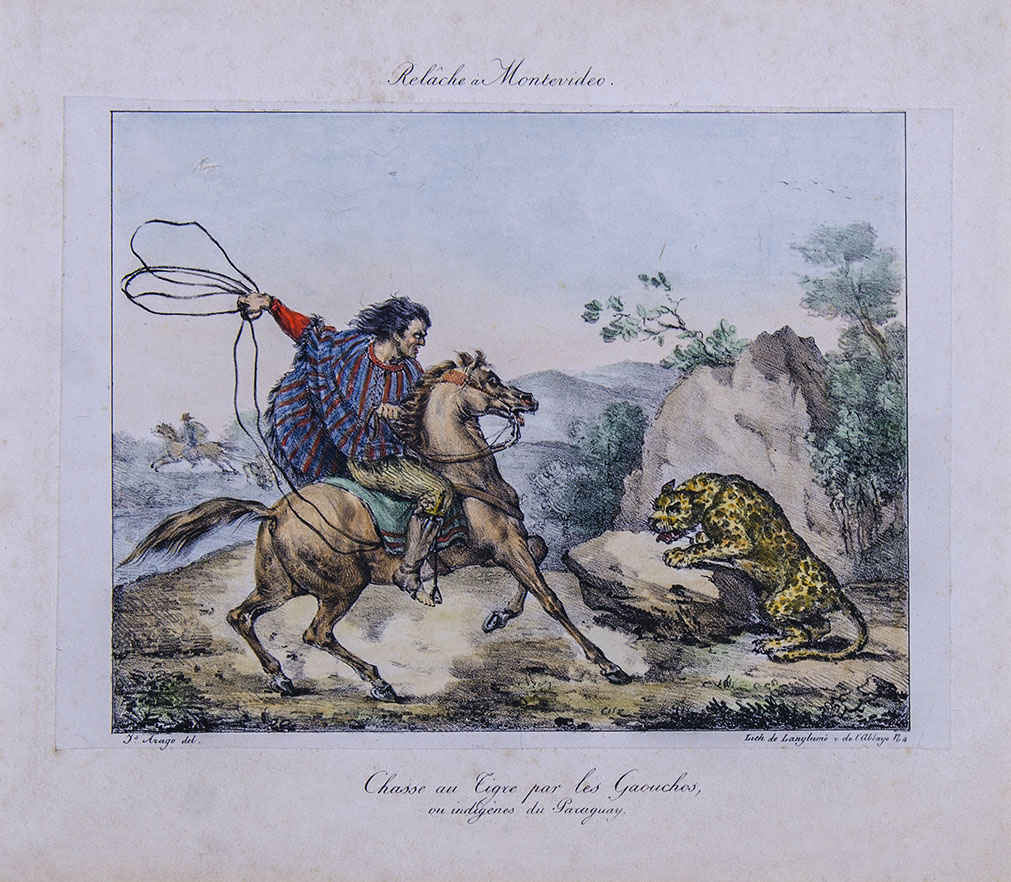Chasse au Tigre par les Gaouchos, ou indigènes du Paraguay.
Chasse au Tigre par les Gaouchos, ou indigènes du Paraguay. Js. Arago del. Lith. de Langlumé , de l´Abbaye N. 4. (París. 1822)
Illuminated lithograph on paper. Measures. Engraving box: 20 x 27.3 cm / 7.87 x 10.74 in. Paper: 26.2 x 38.1 cm / 10.31 x 15 in. Work in very good condition. It is displayed framed.
The plate was included in the work Promenade autour du monde, pendant les années 1817, 1818, 1819 and 1820, sur les corvettes du roi L'Uranie et la Physicienne, commandées par M. Freycinet, published in Paris, in 1822.
The scene, performed with great skill, rich in the expression and tension of movement of its characters, shows us a horseman on horseback about to link a tiger. Its author, Jaques Arago (Estagel, 1799 - Rio de Janeiro, 1845) was a French writer, playwright and cartoonist. Embarked as official draftsman in the scientific expedition commanded by Louis de Freycinet (1817 - 1820), he visited the South American coasts, from Rio de Janeiro to Rio de la Plata, whose lithographs of the drawings made there we see in his "Atlas historique et pittoresque, 1817-1820 ”published in 1822. The present one, under the title Relâche à Montevideo (Rest in Montevideo), whose drawing had been made in the vicinity of that city. Arago lost his sight in 1837.
The subject of the capture of the American tiger (Panthera onca) or jaguar was approached on other occasions by artists and traveling chroniclers. The trade in their skins was recorded in numerous official and private books, and even the Jesuit Dobrizhoffer, assured that "in Santa Fe I met a Spaniard who was a poor man, and with this industry he came to have a great fortune." (1) Julian Mellet also documented tiger hunting in the vicinity of Montevideo. On both banks of the Plata, leather was used as a cuirass among the natives and at that time, also as protection for the back of the horse, placed under the saddle. Emeric E. Vidal himself testifies to his trade by the Pampas Indians in the heart of the city of Buenos Aires in 1819. Years later, the most luxurious caronas were distinguished by the jaguar skin attachments (2) and even, with a whole skin as an overlay.
Note:
1. Florian Paucke: Hacia allá y para acá. Santa Fe, Government of Santa Fe, 2010, p. 104.
2. Roberto Amigo: Modo de hacer corambre de tigre. En Un viajero virreinal. Acuarelas inéditas de la sociedad rioplatense. Buenos Aires, Ed. Hilario. Arts, Letters & Crafts, 2015, pp. 32 - 35.
OMM
| AUTHOR | JACQUES ARAGO |
|---|
Are you interested in selling some works?
Send us an email briefly indicating
which works you intend to put on sale, and we will respond. click here
Subscribe to our newsletter to be updated.
Check our Newsletters